Abstract
This study presents real-time measurements of particulate matter (PM1, PM2.5, PM10) and carbon dioxide (CO2) concentrations across five university indoor environments with varying occupancy levels and natural ventilation conditions. CO2 concentrations frequently exceeded the 1000 ppm guideline, with peak values reaching 3018 ppm and 2715 ppm in lecture spaces, whereas one workshop environment maintained levels well below limits (mean = 668 ppm). PM concentrations varied widely: PM10 reached 541.5 µg/m3 in a carpeted amphitheater, significantly surpassing the 50 µg/m3 legal daily limit, while a well-ventilated classroom exhibited lower levels despite moderate occupancy (PM10 max = 116.9 µg/m3). Elevated PM values were strongly associated with flooring type and occupant movement, not just activity type. Notably, window ventilation during breaks reduced CO2 concentrations by up to 305 ppm (p < 1 × 10−47) and PM10 by over 20% in rooms with favorable layouts. These findings highlight the importance of ventilation strategy, spatial orientation, and surface materials in shaping indoor air quality. The study emphasizes the need for targeted, non-invasive interventions to reduce pollutant exposure in historic university buildings where mechanical ventilation upgrades are often restricted.
1. Introduction
Indoor air quality (IAQ) is a critical factor in maintaining a healthy learning environment, especially in university classrooms where students and faculty spend significant amounts of time. The quality of indoor air significantly influences health, comfort, and occupant performance. Poor IAQ has been linked to various health issues, including respiratory problems, allergies, and decreased cognitive function, which can adversely affect both students’ learning outcomes and faculty performance [1,2,3]. Recently, increased attention has been given to monitoring specific IAQ parameters such as particulate matter (PM1, PM2.5, and PM10), carbon dioxide (CO2) levels, light intensity, temperature, and humidity in educational settings [4,5].
Particulate matter (PM) is a key component of indoor air pollution and is commonly classified based on aerodynamic diameter: PM1 (particles smaller than 1 µm), PM2.5 (smaller than 2.5 µm), and PM10 (smaller than 10 µm). These particles can infiltrate deep into the respiratory tract, with finer particles reaching the alveolar region, thereby posing significant health risks. PM2.5 exacerbates conditions such as asthma and other respiratory diseases, with prolonged exposure linked to severe outcomes, including cardiovascular disease [6,7,8,9,10]. The accumulation of PM in classrooms, where ventilation may be inadequate, poses significant health risks [11,12,13,14,15].
CO2 concentration is another important IAQ parameter, often used to gauge ventilation effectiveness. Elevated indoor CO2 levels result primarily from human respiration and poor ventilation [16,17,18]. High CO2 levels can cause headaches, dizziness, shortness of breath, and impaired cognitive function, which are especially concerning in learning environments. Cognitive functions such as decision-making and problem-solving can be significantly affected when CO2 concentrations exceed 1000 ppm, a common occurrence in poorly ventilated classrooms [19,20,21,22,23,24].
Apart from air quality, environmental factors like light intensity, temperature, and humidity play crucial roles in maintaining a productive classroom environment. Poor lighting can cause eye strain and fatigue, while inappropriate temperature and humidity affect comfort and concentration [25,26,27,28,29]. High humidity can promote mold and dust mites, further degrading IAQ and exacerbating allergies [30,31,32,33,34,35,36].
The adverse health effects of poor IAQ in university classrooms are of significant concern, given the vulnerability of students and faculty who spend long hours in these environments. Exposure to elevated PM levels can lead to acute and chronic respiratory conditions, such as increased bronchitis and asthma rates, especially in individuals with pre-existing respiratory issues. Long-term exposure to high PM10 levels has been linked to several health issues, including cardiovascular diseases and reduced lung function [37,38,39].
Universities must regularly monitor and manage environmental parameters within classrooms, ensuring appropriate ventilation, pollutant control, lighting, temperature, and humidity. Effective measures are essential for fostering a healthy and productive learning environment [40].
The purpose of this study was to investigate the concentration of PM and carbon dioxide CO2 levels in multiple university environments over different experimental conditions.
2. Materials and Methods
The measurement episode was conducted in several distinct areas of the university campus—amphitheaters, laboratories, workshops, and classrooms—at Universitatea Politehnica Timisoara, Romania. These rooms are located across multiple buildings within the central university complex in downtown Timisoara. The measurement episodes were performed on separate days throughout the year.
Detailed layout and window positioning for each room are as follows:
AMPH-1 is located on the ground floor of a heritage-listed main building. The room faces the main road and has large, single-sided windows aligned along the longer wall, offering limited cross-ventilation. The windows are tall but spaced far apart, reducing the efficiency of natural airflow.
AMPH-2, also on the ground floor of the same building as AMPH-1, has a similar street-facing orientation. However, the windows are more evenly distributed and aligned on both sides of the room, providing slightly improved air circulation during the monitoring period.
TOOL-1 is situated on the second floor of a rear technical workshop building facing an internal courtyard. The windows are wide and run across one side of the room, providing modest but continuous natural ventilation.
CLASS-1 is located on the first floor, at the corner of an academic building. It features windows on two perpendicular walls, allowing for effective cross-ventilation and optimal air exchange during the break periods.
LAB-1 is also on the first floor of the same building as CLASS-1 but is located in the middle of the corridor row. It has windows only on one side, limiting airflow to a single direction.
Sampling was conducted on the following specific dates, covering both spring and early spring-to-summer transition periods over 2 academic years (2024–2025).
Table 1 shows the distinct measurement areas with their spatial characteristics.

Table 1.
Areas where measurements were conducted and their characteristics.
Measurements were performed for detecting the concentration of CO2 and PM (PM1; PM2.5; PM10). For CO2, measurements were recorded at 15 s intervals, whereas for particulate matter (PM), a 6 s sampling interval was employed during the measurement process.
Each area is naturally ventilated through open windows, which facilitate air exchange. Natural ventilation is preferable to mechanically enhanced systems, as it avoids additional energy consumption. Furthermore, the majority of the buildings are of historical significance, where the installation of air conditioning units on building façades is prohibited.
Break periods are scheduled every 50 min, allowing for a 10 min interval between classes. This timing has been adopted over the years, in part to address the accumulation of CO2 during class sessions, promoting air exchange and maintaining indoor air quality.
A key factor influencing the results of this study is the spatial orientation of the classrooms in relation to the main road. Table 2 illustrates the positioning of each room relative to this road, which typically experiences heavy traffic congestion. Classrooms with windows facing the main road are expected to exhibit higher concentrations of CO2 and particulate matter (PM) compared to those located on the opposite side of the buildings, adjacent to an internal courtyard area.

Table 2.
Spatial positioning of the rooms.
In addition to vehicle emissions from continuous traffic along the main boulevard, vehicles often idle or stop near the building façade due to nearby traffic light-controlled intersections, contributing to outdoor pollutant buildup. PM infiltration may also be influenced by wind direction, which often carries roadside dust and fine particles toward the street-facing windows. These windows, particularly in AMPH-1 and AMPH-2, are typically opened during breaks, allowing such pollutants to enter directly. In contrast, TOOL-1, CLASS-1, and LAB-1 face the quieter, greener internal courtyard, with fewer external sources of pollution. The courtyard also benefits from vegetative cover, which may help reduce incoming dust and particles by acting as a natural buffer.
These factors likely explain the notable differences observed between indoor spaces with identical ventilation practices but differing outdoor exposures.
For the analysis of indoor air quality, two different types of sensors were employed: one for measuring CO2 concentration and another for measuring PM.
CO2 was measured using a Testo infrared (IR) sensor, product no. 0632 1543, manufactured by Testo SE & Co. KGaA (Titisee-Neustadt, Baden-Württemberg, Germany), specifically designed for accurate, real-time CO2 monitoring. The Testo IR sensor operates based on the non-dispersive infrared (NDIR) technology, which detects CO2 by measuring the absorption of infrared light at specific wavelengths [41]. The sensor consists of an infrared light source, a gas sample chamber, and a detector. As the infrared light passes through the air sample, CO2 molecules absorb specific wavelengths of light, and the amount of absorbed light is directly correlated with the CO2 concentration. This method allows for highly reliable and precise CO2 measurements, making it ideal for monitoring indoor air quality in both static and dynamic environments.
PM concentrations were measured using a DLS-type (Dynamic Light Scattering) sensor, part of a portable aerosol spectrometer, model number 1.109, manufactured by DURAG GROUP (Hamburg, Germany). This type of sensor is commonly used for detecting and quantifying particulate matter, including PM1, PM2.5, and PM10. The DLS sensor works by scattering light as it passes through a volume of air containing particles. The intensity of the scattered light is directly related to the concentration and size distribution of the particles in the air. The sensor uses a laser or LED light source, and as particles scatter the light, the sensor measures the scattered signal. This information is then processed to determine the concentration of PM in the air, providing accurate and real-time readings of particulate matter levels.
To assess the influence of outdoor air pollution on particulate matter (PM) concentration levels, an external sensor was continuously operated throughout the indoor measurement periods. This enabled a comparative analysis to determine whether outdoor PM concentrations affected indoor levels, given that the rooms are naturally ventilated through open windows. The sensor used for outdoor PM concentration measurements is of a DLS-type, manufactured by Airly Sp. Z o.o. (Kraków, Poland).
All sensors were calibrated and deployed in the university environments to provide continuous measurements of CO2 and PM concentrations, offering insight into air quality variations during the measurement episodes.
3. Results and Interpretations
Results and interpretations are split into two subchapters representing CO2 and OM concentrations found during the different measurement episodes and university areas.
3.1. CO2 Concentrations
According to air quality directives of the European Union, the maximum allowed concentration limit of CO2 is 1000 ppm [42].
CO2 concentration measurements for each experimental condition presented in the previous chapter are represented below (AMPH-1 Figure 1; AMPH-2 Figure 2; TOOL-1 Figure 3; CLASS-1 Figure 4; LAB-1 Figure 5), including the window configurations, opened or closed partially, for a specific amount of time, or during the entire episode.
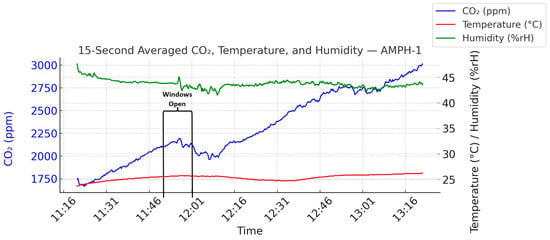
Figure 1.
Concentrations of CO2 during the measurement episode inside the amphitheater under experimental conditions described for AMPH-1.
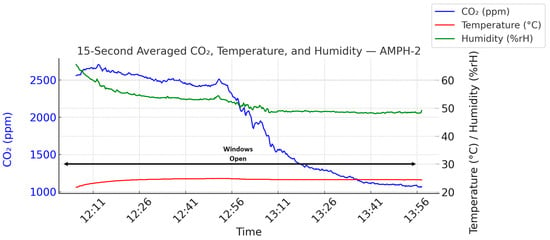
Figure 2.
Concentrations of CO2 during the 2 h measurement episode inside the second amphitheater under experimental conditions described for AMPH-2.
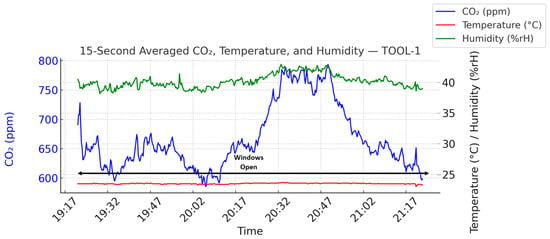
Figure 3.
Concentrations of CO2 during the 2 h measurement episode inside the tool workshop under experimental conditions described for TOOL-1.
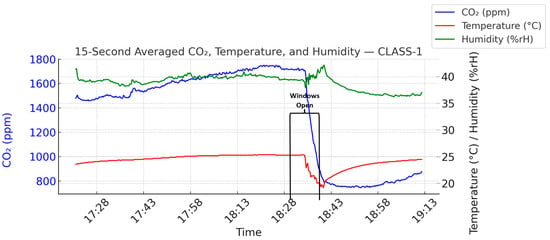
Figure 4.
Concentrations of CO2 during the 2 h measurement episode inside the classroom under experimental conditions described for CLASS-1.
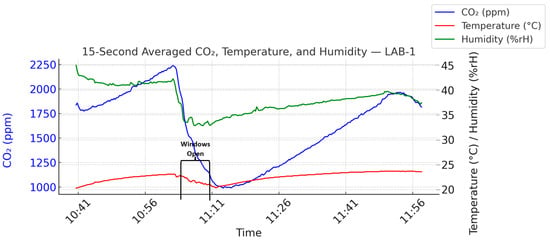
Figure 5.
Concentrations of CO2 during the 2 h measurement episode inside the laboratory under experimental conditions described for LAB-1.
During the AMPH-1 measurement episode, windows were open during a study break time of 10 min between 11:50 and 12:00 h.
During the AMPH-2 measurement episode, the windows were opened at the start of the monitoring period and remained open for the duration of the episode.
During the TOOL-1 measurement episode, windows constantly open.
During the CLASS-1 measurement episode, windows were opened only during the break for 10 min between 18:30 and 18:40 h.
During the LAB-1 measurement episode, windows were opened only during the break for 10 min between 11:00 and 11:10 h.
Minimum and maximum reached CO2 concentrations are represented in Table 3 (red colored text represents CO2 values exceeding the allowed limit of 1000 ppm).

Table 3.
Minimum and maximum concentrations of CO2 recorded during each measurement episode under the respective experimental conditions in the different areas.
Several statistical analyses were conducted, including one-sample or paired t-tests (depending on whether only open-window data or both open and closed conditions were available), along with calculations of Cohen’s d for effect size and Wilcoxon signed-rank tests for non-parametric comparison.
CO2 concentration patterns and air quality varied markedly across the experimental conditions due to differences in ventilation quality, occupancy, and spatial configuration. In AMPH-1, a slight dip in CO2 after a break was followed by a steady increase, suggesting ineffective ventilation. While this change was statistically significant (p = 4.6 × 10−10), the small effect size (Cohen’s d = 0.26) confirms only a minor practical improvement when windows were opened, likely due to suboptimal window positioning and inadequate airflow capacity. In AMPH-2, CO2 concentrations consistently decreased over time yet remained substantially above the 1000 ppm threshold (mean = 1906 ppm, p = 1.6 × 10−29, Cohen’s d = 1.45), indicating persistent air quality issues. The improvement likely resulted from better window placement and partial ventilation, but high initial values—likely from prior occupancy and poor pre-ventilation—tempered the overall effectiveness.
In contrast, TOOL-1 displayed excellent air quality. CO2 levels averaged 668 ppm (p < 0.0001, Cohen’s d = −6.08), well below recommended limits. This strong result is likely due to favorable room orientation (facing a vegetated courtyard), which reduced external pollution and enhanced passive ventilation. Temperature and humidity were also significantly lower than baselines, reinforcing the room’s conducive environmental characteristics.
CLASS-1 showed the most effective dynamic response to ventilation, with CO2 dropping from 1708 ppm to 1436 ppm after window opening (p = 4.7 × 10−69, Cohen’s d = 0.82). This condition benefited from a corner layout and cross-ventilation via windows on two perpendicular walls. Although occupancy was moderately high (70%), the spatial configuration enabled substantial improvement. A minor post-break CO2 rise reflected normal occupant activity. LAB-1 shared a similar trend but with a higher occupancy (93%), leading to faster CO2 accumulation post-break. Still, window opening yielded a meaningful drop from 2049 ppm to 1744 ppm (p = 2.5 × 10−47, Cohen’s d = 0.65). Notably, humidity dropped significantly (Cohen’s d = 1.2), underscoring the strong drying effect of ventilation.
3.2. Indoor PM Concentrations
As a general statement, which follows all recorded results, PM2.5 and PM10 are regulated by either European Union Directives (PM2.5) or by the Romanian Law (PM10), with PM2.5 having an annual average limit of 20 µg/Nm3 [43], and PM10 having a daily limit of 50 µg/Nm3 [44]. Neither the European Union nor the Romanian Law regulates PM1 limits.
PM concentration measurements for each experimental condition presented in the previous chapter are represented below (AMPH-1 Figure 6; AMPH-2 Figure 7; TOOL-1 Figure 8; CLASS-1 Figure 9; LAB-1 Figure 10), including the window configurations, opened or closed partially, for a specific amount of time, or during the entire episode.
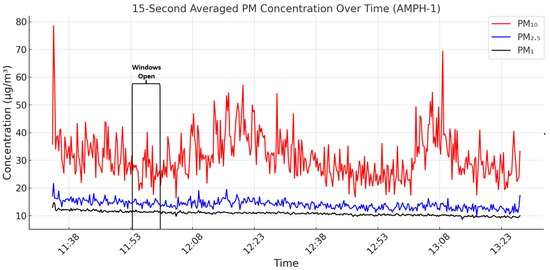
Figure 6.
Concentrations of PM during the measurement episode inside the amphitheater under experimental conditions described for AMPH-1.
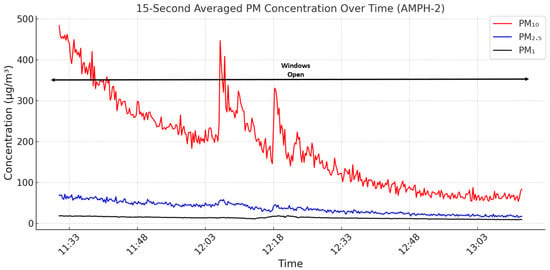
Figure 7.
Concentrations of PM during the measurement episode inside the second amphitheater under experimental conditions described for AMPH-2.
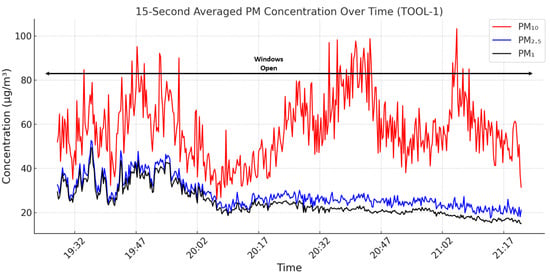
Figure 8.
Concentrations of PM during the measurement episode inside the tool workshop under experimental conditions described for TOOL-1.
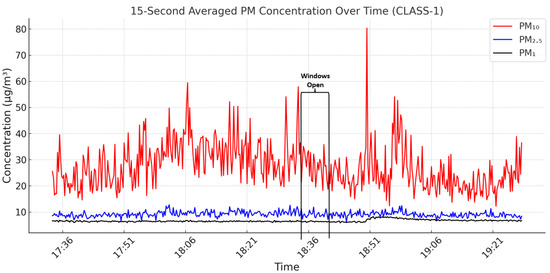
Figure 9.
Concentrations of PM during the measurement episode inside the classroom under experimental conditions described for CLASS-1.
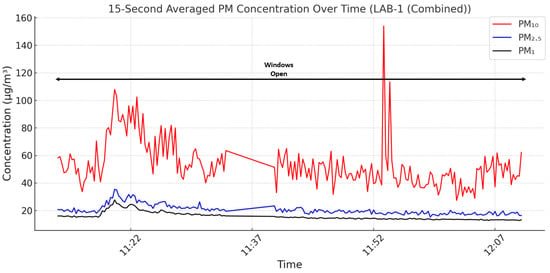
Figure 10.
Concentrations of PM during the measurement episode inside the laboratory under experimental conditions described for LAB-1.
During the AMPH-1 measurement episode, windows were open during a study break time of 10 min between 11:50 and 12:00 h.
During the AMPH-2 measurement episode, the windows were opened at the start of the monitoring period and remained open for the duration of the episode.
During the TOOL-1 measurement episode, windows were constantly open.
During the CLASS-1 measurement episode, windows were opened only during the break for 10 min between 18:30 and 18:40 h.
During the LAB-1 measurement episode, windows were opened only during the break for 10 min between 11:00 and 11:10 h. Two sets of measurements are shown next to each other due to a power outage during the measurement episode.
Minimum and maximum reached PM concentrations indoors are represented in Table 4 (red colored text represents PM10 values exceeding the allowed daily limit of 50 µg/Nm3; PM2.5 has an annual limit, therefore inconclusive for only a daily measurement episode, and PM1 is unregulated). Outdoor PM concentration levels are also included in the table, representing only the maximum values recorded during the measurement episode. These values are indicated by the label “Max(out)”.

Table 4.
Minimum and maximum concentrations of PM recorded during each measurement episode under the respective experimental conditions in the different areas.
The same kinds of statistical analyses as for CO2 were used for PM.
PM concentration trends across experimental conditions varied due to room use, ventilation, occupancy, and surface materials. In AMPH-1, PM levels remained mostly within permissible limits, with occasional PM10 exceedances. Statistically significant reductions were observed when windows were opened—PM10 dropped from 34.94 to 27.75 µg/m3 (p = 1.8 × 10−6, d = 0.51), PM2.5 from 15.78 to 14.61 µg/m3 (p = 1.0 × 10−5, d = 0.47), and PM1 from 12.24 to 11.45 µg/m3 (p = 2.0 × 10−11, d = 0.76)—reflecting moderate ventilation impact despite spatial limitations. In AMPH-2, although PM showed a decreasing trend, values were significantly above limits: medians reached 176.5 µg/m3 for PM10 (p = 2.3 × 10−168), 35.2 for PM2.5 (p = 4.5 × 10−142), and 13.6 for PM1 (p = 3.4 × 10−156). The extreme pollution levels and the pronounced difference between PM10 and smaller particle sizes are likely due to dust-trapping carpet over wood flooring, which released coarse particles during occupant movement [45,46,47], overwhelming the benefits of good window positioning.
TOOL-1 showed persistently high PM values despite open windows. PM10 averaged 58.15 µg/m3 (p = 6.2 × 10−50, d = 0.46), PM2.5 was 28.24 (p = 4.7 × 10−221, d = 1.2), and PM1 reached 24.79 (p < 1 × 10−300, d = 2.08), all far above standard thresholds. These elevations are strongly linked to indoor metalworking activity [48] and possible infiltration from polluted outdoor air. In CLASS-1, PM levels were low and stable. PM10 dropped significantly from 36.44 to 30.79 µg/m3 with window opening (p = 6.3 × 10−4, d = 0.35), while PM2.5 and PM1 changes were minimal and of limited practical significance (PM2.5: p = 0.26, d = 0.11; PM1: p = 0.032, d = 0.22). Tiled flooring and minimal external PM infiltration contributed to the favorable indoor environment.
LAB-1 exhibited higher PM levels than CLASS-1, driven by increased occupancy and an incidental chalk dust release. PM10 averaged 53.83 µg/m3 (p = 1.71 × 10−4, d = 0.17), slightly above the 50 µg/m3 baseline. PM2.5 showed a marginal increase (20.52 µg/m3; p = 2.89 × 10−3, d = 0.13), but PM1 was substantially elevated at 15.83 µg/m3 (p = 2.98 × 10−179, d = 1.97), indicating strong impact from fine particles, likely exacerbated by both occupant activity [49] and outdoor PM infiltration during the open-window period.
4. Conclusions
This investigation revealed that indoor air quality across university environments is highly dependent on room characteristics, ventilation, and human activity. CO2 levels exceeded the 1000 ppm threshold in four out of five environments, with AMPH-1 recording a maximum of 3018 ppm and LAB-1 reaching 2251 ppm. Although TOOL-1 demonstrated ideal CO2 conditions (mean = 668 ppm), its PM10 levels were substantially elevated (max = 140.3 µg/m3), likely due to metalworking and dust infiltration.
Amphitheater AMPH-2 exhibited the most severe PM10 pollution (median = 176.5 µg/m3, max = 541.5 µg/m3), exacerbated by carpet flooring that resuspended coarse particles. LAB-1 and CLASS-1, both facing internal courtyards, showed better ventilation outcomes. For instance, window opening in LAB-1 reduced PM10 by 21.9% (from 57.3 to 44.8 µg/m3) and CO2 by 305 ppm (from 2049 to 1744 ppm, p = 2.5 × 10−47). CLASS-1 benefited from cross-ventilation, achieving a 15.9% reduction in CO2 (from 1708 to 1436 ppm, p = 4.7 × 10−69).
Importantly, surface materials and occupant motion emerged as stronger predictors of indoor PM levels than the type of activity performed. AMPH-2, despite low-impact activities, showed more PM pollution than TOOL-1 due to its carpeting. These results call for targeted interventions: entrance matting systems, minimized textile surfaces, occupancy scheduling, and break-time ventilation. For heritage buildings with natural ventilation constraints, such pragmatic strategies are essential for mitigating health risks related to PM and CO2 exposure.
Author Contributions
Conceptualization, D.-M.M.; methodology, D.B. and R.-M.B.; software, D.-M.M. and A.A.; validation, I.I. and D.B.; formal analysis, D.-M.M. and D.B.; investigation, D.-M.M.; resources, I.I.; writing—original draft preparation, D.-M.M.; writing—review and editing, D.-M.M.; supervision, I.I. All authors have read and agreed to the published version of the manuscript.
Funding
This research received no external funding.
Institutional Review Board Statement
Not applicable.
Informed Consent Statement
Not applicable.
Data Availability Statement
Data are contained within the article as variable values and graphical representations.
Acknowledgments
The authors would like to acknowledge Nicolae Muntean for having the initiative for performing such real-time measurements in university settings.
Conflicts of Interest
The authors declare no conflicts of interest.
References
- Sadrizadeh, S.; Yao, R.; Yuan, F.; Awbi, H.; Bahnfleth, W.; Bi, Y.; Cao, G.; Croitoru, C.; De Dear, R.; Haghighat, F.; et al. Indoor air quality and health in schools: A critical review for developing the roadmap for the future school environment. J. Build. Eng. 2022, 57, 104908. [Google Scholar] [CrossRef]
- Pulimeno, M.; Piscitelli, P.; Colazzo, S.; Colao, A.; Miani, A. Indoor air quality at school and students’ performance: Recommendations of the UNESCO Chair on Health Education and Sustainable Development & the Italian Society of Environmental Medicine (SIMA). Health Promot. Perspect. 2020, 10, 169–174. [Google Scholar] [CrossRef] [PubMed]
- Mendell, M.; Heath, G. Do indoor pollutants and thermal conditions in schools influence student performance? A critical review of literature. Indoor Air 2005, 15, 27–52. [Google Scholar] [CrossRef]
- Chatzidiakou, L.; Archer, R.; Beale, V.; Bland, S.; Carter, H.; Castro-Faccetti, C.; Edwards, H.; Finneran, J.; Hama, S.; Jones, R.L.; et al. Schools’ air quality monitoring for health and education: Methods and protocols of the SAMHE initiative and project. Dev. Built Environ. 2023, 16, 100266. [Google Scholar] [CrossRef]
- Kochavi, S.A.; Kira, O.; Gal, E. Real-Time Monitoring of Environmental Parameters in Schools to Improve Indoor Resilience Under Extreme Events. Smart Cities 2025, 8, 7. [Google Scholar] [CrossRef]
- Gokul, T.; Kumar, K.R.; Prema, P.; Arun, A.; Balaji, P.; Faggio, C. Particulate pollution and its toxicity to fish: An overview. Comp. Biochem. Physiol. Part C Toxicol. Pharmacol. 2023, 270, 109646. [Google Scholar] [CrossRef] [PubMed]
- Sangkham, S.; Phairuang, W.; Sherchan, S.P.; Pansakun, N.; Munkong, N.; Sarndhong, K.; Islam, M.A.; Sakunkoo, P. An update on adverse health effects from exposure to PM2.5. Environ. Adv. 2024, 18, 100603. [Google Scholar] [CrossRef]
- Mahiyuddin, W.R.W.; Ismail, R.; Mohammad Sham, N.; Ahmad, N.I.; Nik Hassan, N.M.N. Cardiovascular and Respiratory Health Effects of Fine Particulate Matters (PM2.5): A Review on Time Series Studies. Atmosphere 2023, 14, 856. [Google Scholar] [CrossRef]
- Contini, D.; Costabile, F. Air Pollution, Health Effects Indicators, the Exposome, and One Health. Atmosphere 2024, 15, 618. [Google Scholar] [CrossRef]
- Chauhan, B.V.S.; Corada, K.; Young, C.; Smallbone, K.L.; Wyche, K.P. Review on Sampling Methods and Health Impacts of Fine (PM2.5, ≤2.5 µm) and Ultrafine (UFP, PM0.1, ≤0.1 µm) Particles. Atmosphere 2024, 15, 572. [Google Scholar] [CrossRef]
- Hama, S.; Kumar, P.; Tiwari, A.; Wang, Y.; Linden, P.F. The underpinning factors affecting the classroom air quality, thermal comfort and ventilation in 30 classrooms of primary schools in London. Environ. Res. 2023, 236, 116863. [Google Scholar] [CrossRef]
- Canha, N.; Correia, C.; Mendez, S.; Gamelas, C.A.; Felizardo, M. Monitoring Indoor Air Quality in Classrooms Using Low-Cost Sensors: Does the Perception of Teachers Match Reality? Atmosphere 2024, 15, 1450. [Google Scholar] [CrossRef]
- Trompetter, W.J.; Boulic, M.; Ancelet, T.; Garcia-Ramirez, J.C.; Davy, P.K.; Wang, Y.; Phipps, R. The effect of ventilation on air particulate matter in school classrooms. J. Build. Eng. 2018, 18, 164–171. [Google Scholar] [CrossRef]
- Xia, T.; Raneses, J.; Schmiesing, B.; Garcia, R.; Walding, A.; DeMajo, R.; Schulz, A.; Batterman, S.A. How teacher behaviors and perceptions, air change rates, and portable air purifiers affect indoor air quality in naturally ventilated schools. Front. Public Health 2024, 12, 1427116. [Google Scholar] [CrossRef]
- Settimo, G.; Indinnimeo, L.; Inglessis, M.; De Felice, M.; Morlino, R.; di Coste, A.; Carriera, F.; Di Fiore, C.; Avino, P. CO2 Levels in Classrooms: What Actions to Take to Improve the Quality of Environments and Spaces. Sustainability 2024, 16, 8619. [Google Scholar] [CrossRef]
- Fan, G.; Chang, H.; Sang, C.; Chen, Y.; Ning, B.; Liu, C. Evaluating Indoor Carbon Dioxide Concentration and Ventilation Rate of Research Student Offices in Chinese Universities: A Case Study. Processes 2022, 10, 1434. [Google Scholar] [CrossRef]
- Wang, P.; Zhou, W.; Niu, Z.; Huo, D.; Zhou, J.; Li, H.; Cheng, P.; Wu, S.; Xiong, X.; Chen, N. An Approach for Assessing Human Respiration CO2 Emissions Using Radiocarbon Measurements and Bottom-Up Data Sets. J. Geophys. Res. Atmos. 2024, 129, e2023JD040578. [Google Scholar] [CrossRef]
- Li, M.; Bekö, G.; Zannoni, N.; Pugliese, G.; Carrito, M.; Cera, N.; Moura, C.; Wargocki, P.; Vasconcelos, P.; Nobre, P.; et al. Human metabolic emissions of carbon dioxide and methane and their implications for carbon emissions. Sci. Total Environ. 2022, 833, 155241. [Google Scholar] [CrossRef]
- Allen, J.G.; MacNaughton, P.; Satish, U.; Santanam, S.; Vallarino, J.; Spengler, J.D. Associations of Cognitive Function Scores with Carbon Dioxide, Ventilation, and Volatile Organic Compound Exposures in Office Workers: A Controlled Exposure Study of Green and Conventional Office Environments. Environ. Health Perspect. 2015, 124, 805–812. [Google Scholar] [CrossRef]
- Scully, R.R.; Basner, M.; Nasrini, J.; Lam, C.-w.; Hermosillo, E.; Gur, R.C.; Moore, T.; Alexander, D.J.; Satish, U.; Ryder, V.E. Effects of acute exposures to carbon dioxide on decision making and cognition in astronaut-like subjects. npj Microgravity 2019, 5, 17. [Google Scholar] [CrossRef]
- Snow, S.; Boyson, A.S.; Paas, K.H.; Gough, H.; King, M.-F.; Barlow, J.; Noakes, C.J. Exploring the physiological, neurophysiological and cognitive performance effects of elevated carbon dioxide concentrations indoors. Build. Environ. 2019, 156, 243–252. [Google Scholar] [CrossRef]
- Du, B.; Tandoc, M.C.; Mack, M.L.; Siegel, J.A. Indoor CO2 concentrations and cognitive function: A critical review. Indoor Air 2020, 30, 1067–1082. [Google Scholar] [CrossRef]
- Lowe, R.J.; Huebner, G.M.; Oreszczyn, T. Possible future impacts of elevated levels of atmospheric CO2 on human cognitive performance and on the design and operation of ventilation systems in buildings. Build. Serv. Eng. Res. Technol. 2018, 39, 698–711. [Google Scholar] [CrossRef]
- Cao, X.; Li, P.; Zhang, J.; Pang, L. Associations of Human Cognitive Abilities with Elevated Carbon Dioxide Concentrations in an Enclosed Chamber. Atmosphere 2022, 13, 891. [Google Scholar] [CrossRef]
- Yin, B.; Fang, W.; Liu, L.; Guo, Y.; Ma, X.; Di, Q. Effect of extreme high temperature on cognitive function at different time scales: A national difference-in-differences analysis. Ecotoxicol. Environ. Saf. 2024, 275, 116238. [Google Scholar] [CrossRef]
- Trezza, B.M.; Apolinario, D.; Sanchez de Oliveira, R.; Busse, A.L.; Teixeira Goncalves, F.L.; Nascimento Saldiva, P.H.; Jacob-Filho, W. Environmental heat exposure and cognitive performance in older adults: A controlled trial. Age 2015, 37, 43. [Google Scholar] [CrossRef]
- Tian, C.; Li, H.; Tian, S.; Tian, F.; Yang, H. The neurocognitive mechanism linking temperature and humidity with miners’ alertness: An fNIRS study. Sci. Rep. 2024, 14, 11796. [Google Scholar] [CrossRef]
- Chen, Y.; Tao, M.; Liu, W. High temperature impairs cognitive performance during a moderate intensity activity. Build. Environ. 2020, 186, 107372. [Google Scholar] [CrossRef]
- Khan, A.M.; Finlay, J.M.; Clarke, P.; Sol, K.; Melendez, R.; Judd, S.; Gronlund, C.J. Association between temperature exposure and cognition: A cross-sectional analysis of 20,687 aging adults in the United States. BMC Public Health 2021, 21, 1484. [Google Scholar] [CrossRef] [PubMed]
- Portnoy, J.; Miller, J.D.; Williams, P.B.; Chew, G.L.; Miller, J.D.; Zaitoun, F.; Phipatanakul, W.; Kennedy, K.; Barnes, C.; Grimes, C.; et al. Environmental assessment and exposure control of dust mites: A practice parameter. Ann. Allergy Asthma Immunol. 2013, 111, 465–507. [Google Scholar] [CrossRef] [PubMed]
- Arlian, L.G.; Platts-Mills, T.A.E. The biology of dust mites and the remediation of mite allergens in allergic disease. J. Allergy Clin. Immunol. 2001, 107, S406–S413. [Google Scholar] [CrossRef]
- Andersen, I.; Korsgaard, J. Asthma and the indoor environment: Assessment of the health implications of high indoor air humidity. Environ. Int. 1986, 12, 121–127. [Google Scholar] [CrossRef]
- Xue, Q.; Zou, M.; Guo, J.; Teng, Q.; Zhang, Q.; Sheng, L.; Xu, S.; Fang, C.; Yao, N.; Li, Y.; et al. Detection and assessment of dust mite allergens in an indoor environment in Anhui, China. Environ. Sci. Pollut. Res. 2022, 30, 3045–3055. [Google Scholar] [CrossRef]
- Charpin, D. Climate change and house-dust mite allergy. J. Clim. Change Health 2021, 2, 100012. [Google Scholar] [CrossRef]
- Mendell, M.J.; Mirer, A.G.; Cheung, K.; Tong, M.; Douwes, J. Respiratory and Allergic Health Effects of Dampness, Mold, and Dampness-Related Agents: A Review of the Epidemiologic Evidence. Environ. Health Perspect. 2011, 119, 748–756. [Google Scholar] [CrossRef]
- Lee, S.; Ryu, S.; Kim, S.; Kim, D.; Seo, S. Association of exposure to indoor molds and dampness with allergic diseases at water-damaged dwellings in Korea. Sci. Rep. 2024, 14, 135. [Google Scholar] [CrossRef] [PubMed]
- Ni, R.; Su, H.; Burnett, R.T.; Guo, Y.; Cheng, Y. Long-term exposure to PM2.5 has significant adverse effects on childhood and adult asthma: A global meta-analysis and health impact assessment. One Earth 2024, 7, 1953–1969. [Google Scholar] [CrossRef]
- Wu, J.-Z.; Ge, D.-D.; Zhou, L.-F.; Hou, L.-Y.; Zhou, Y.; Li, Q.-Y. Effects of particulate matter on allergic respiratory diseases. Chronic Dis. Transl. Med. 2018, 4, 95–102. [Google Scholar] [CrossRef]
- Streinu, D.-R.; Neagoe, O.C.; Borlea, A.; Icma, I.; Derban, M.; Stoian, D. Enhancing diagnostic precision in thyroid nodule assessment: Evaluating the efficacy of a novel cell preservation technique in fine-needle aspiration cytology. Front. Endocrinol. 2024, 15, 1438063. [Google Scholar] [CrossRef]
- Alinier, G.; Hssain, I. Chapter 16—Creating Effective Learning Environments: The Educator’s Perspective. In Clinical Simulation, 2nd ed.; Academic Press: New York, NY, USA, 2019; pp. 217–227. [Google Scholar] [CrossRef]
- Testo. Available online: https://www.testo.com/en-UK/iaq-probe-for-analyzing-indoor-air-quality-co-sub-2-/sub/p/0632-1543#tab-technicalData (accessed on 31 January 2025).
- European Agency for Safety and Health at Work. Available online: https://oshwiki.osha.europa.eu/en/themes/indoor-air-quality-iaq (accessed on 31 January 2025).
- EUR-Lex. Available online: https://eur-lex.europa.eu/legal-content/en/ALL/?uri=CELEX:32008L0050 (accessed on 31 January 2025).
- Romanian Law No. 104 from 15 June 2011 in Relation to Air Quality (Original in Romanian: LEGE Nr. 104 Din 15 Iunie 2011 Privind Calitatea Aerului Înconjurător) Parliament of Romania. Available online: https://legislatie.just.ro/Public/DetaliiDocument/129642 (accessed on 31 January 2025).
- Fu, N.; Keun Kim, M.; Huang, L.; Liu, J.; Chen, B.; Sharples, S. Experimental and numerical analysis of indoor air quality affected by outdoor air particulate levels (PM1.0, PM2.5 and PM10), room infiltration rate, and occupants’ behaviour. Sci. Total Environ. 2022, 851 Pt 2, 158026. [Google Scholar] [CrossRef]
- Becher, R.; Øvrevik, J.; Schwarze, P.E.; Nilsen, S.; Hongslo, J.K.; Bakke, J.V. Do Carpets Impair Indoor Air Quality and Cause Adverse Health Outcomes: A Review. Int. J. Environ. Res. Public Health 2018, 15, 184. [Google Scholar] [CrossRef] [PubMed]
- Mangin, T.; Barrett, Z.; Palmer, Z.; Tang, D.; Nielson, S.; Sleeth, D.; Kelly, K. Understanding the effect of outdoor pollution episodes and HVAC type on indoor air quality. Build. Environ. 2025, 278, 112978. [Google Scholar] [CrossRef]
- Yao, H.; Qiu, S.; Lv, Y.; Wei, S.; Li, A.; Long, Z.; Wu, W.; Shen, X. Indoor Particulate Matter Transfer in CNC Machining Workshop and The Influence of Ventilation Strategies—A Case Study. Sustainability 2023, 15, 6227. [Google Scholar] [CrossRef]
- Licina, D.; Tian, Y.; Nazaroff, W.W. Emission rates and the personal cloud effect associated with particle release from the perihuman environment. Indoor Air 2017, 27, 791–802. [Google Scholar] [CrossRef] [PubMed]
Disclaimer/Publisher’s Note: The statements, opinions and data contained in all publications are solely those of the individual author(s) and contributor(s) and not of MDPI and/or the editor(s). MDPI and/or the editor(s) disclaim responsibility for any injury to people or property resulting from any ideas, methods, instructions or products referred to in the content. |
© 2025 by the authors. Licensee MDPI, Basel, Switzerland. This article is an open access article distributed under the terms and conditions of the Creative Commons Attribution (CC BY) license (https://creativecommons.org/licenses/by/4.0/).